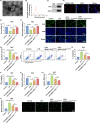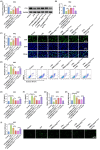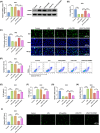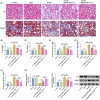Curcumin-induced exosomal FTO from bone marrow stem cells alleviates sepsis-associated acute kidney injury by modulating the m6A methylation of OXSR1
- PMID: 39739936
- PMCID: PMC11827542
- DOI: 10.1002/kjm2.12923
Curcumin-induced exosomal FTO from bone marrow stem cells alleviates sepsis-associated acute kidney injury by modulating the m6A methylation of OXSR1
Abstract
Curcumin and bone marrow stem cells (BMSCs)-derived exosomes are considered to be useful for the treatment of many human diseases, including sepsis-associated acute kidney injury (SA-AKI). However, the role and underlying molecular mechanism of curcumin-loaded BMSCs-derived exosomes in the progression of SA-AKI remain unclear. Exosomes (BMSCs-EXOCurcumin or BMSCs-EXOControl) were isolated from curcumin or DMSO-treated BMSCs, and then co-cultured with LPS-induced HK2 cells. Cell proliferation and apoptosis were determined by cell counting kit 8 (CCK8) assay, 5-ethynyl-2-deoxyuridine (EdU) assay, and flow cytometry. Enzyme-linked immunosorbent assay (ELISA) was used for examining inflammatory factors. The levels of SOD, MDA, and ROS were tested to assess oxidative stress. The levels of fat mass and obesity-associated protein (FTO) and oxidative stress responsive 1 (OXSR1) were detected by quantitative real-time PCR and western blot. Methylated RNA immunoprecipitation (MeRIP) assay and RNA immunoprecipitation (RIP) assay were used for measuring the interaction between FTO and OXSR1. BMSCs-EXOCurcumin treatment could inhibit LPS-induced HK2 cell apoptosis, inflammation, and oxidative stress. FTO was downregulated in SA-AKI patients and LPS-induced HK2 cells, while was upregulated in BMSCs-EXOCurcumin. Exosomal FTO from curcumin-induced BMSCs suppressed apoptosis, inflammation, and oxidative stress in LPS-induced HK2 cells. FTO decreased OXSR1 expression through m6A modification, and the inhibitory effect of FTO on LPS-induced HK2 cell injury could be eliminated by OXSR1 overexpression. In animal experiments, BMSCs-EXOCurcumin alleviated kidney injury in SA-AKI mice models by regulating FTO/OXSR1 axis. In conclusion, exosomal FTO from curcumin-induced BMSCs reduced OXSR1 expression to alleviate LPS-induced HK2 cell injury and improve kidney function in CLP-induced mice models, providing a new target for SA-AKI.
Keywords: FTO; OXSR1; bone marrow stem cells; exosomes; sepsis‐associated AKI.
© 2024 The Author(s). The Kaohsiung Journal of Medical Sciences published by John Wiley & Sons Australia, Ltd on behalf of Kaohsiung Medical University.
Conflict of interest statement
The authors declare no conflicts of interest.
Figures







Similar articles
-
Knockdown of circ-FANCA alleviates LPS-induced HK2 cell injury via targeting miR-93-5p/OXSR1 axis in septic acute kidney injury.Diabetol Metab Syndr. 2021 Jan 19;13(1):7. doi: 10.1186/s13098-021-00625-8. Diabetol Metab Syndr. 2021. PMID: 33468219 Free PMC article.
-
Resveratrol Inhibits circ_0074371-related Pathway to Alleviate Sepsis-induced Acute Kidney Injury.Biochem Genet. 2024 Jun;62(3):1779-1794. doi: 10.1007/s10528-023-10517-3. Epub 2023 Sep 20. Biochem Genet. 2024. PMID: 37730967
-
CircNRIP1 KNOCKDOWN ALLEVIATES LIPOPOLYSACCHARIDE-INDUCED HUMAN KIDNEY 2 CELL APOPTOSIS AND INFLAMMATION THROUGH miR-339-5p/OXSR1 PATHWAY.Shock. 2023 Mar 1;59(3):426-433. doi: 10.1097/SHK.0000000000002057. Epub 2023 Jan 8. Shock. 2023. PMID: 36609531
-
Efficacy of exosomes in acute kidney injury treatment and the associated mechanism (Review).Mol Med Rep. 2025 May;31(5):137. doi: 10.3892/mmr.2025.13503. Epub 2025 Mar 27. Mol Med Rep. 2025. PMID: 40145555 Free PMC article. Review.
-
Molecular insights and clinical implications of DNA methylation in sepsis-associated acute kidney injury: a narrative review.BMC Nephrol. 2025 May 22;26(1):253. doi: 10.1186/s12882-025-04179-z. BMC Nephrol. 2025. PMID: 40405102 Free PMC article. Review.
Cited by
-
Mechanisms and Clinical Application Prospects of Curcumin in the Treatment of Sepsis.J Inflamm Res. 2025 Jul 22;18:9627-9636. doi: 10.2147/JIR.S536551. eCollection 2025. J Inflamm Res. 2025. PMID: 40727460 Free PMC article. Review.
References
MeSH terms
Substances
LinkOut - more resources
Full Text Sources
Medical
Miscellaneous

